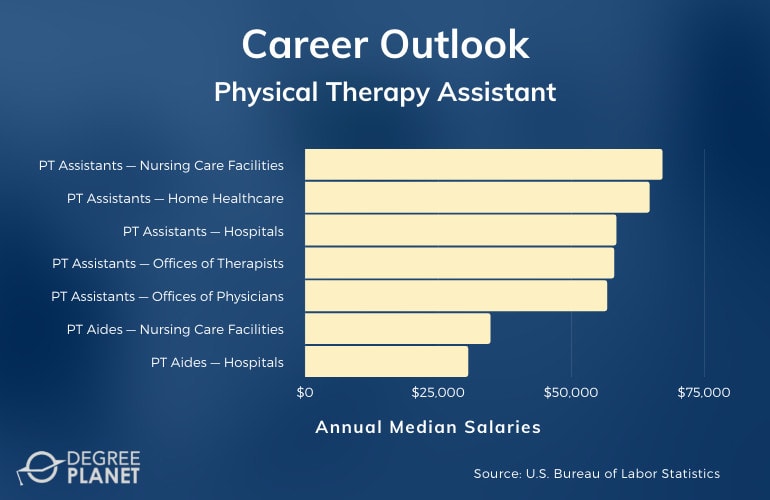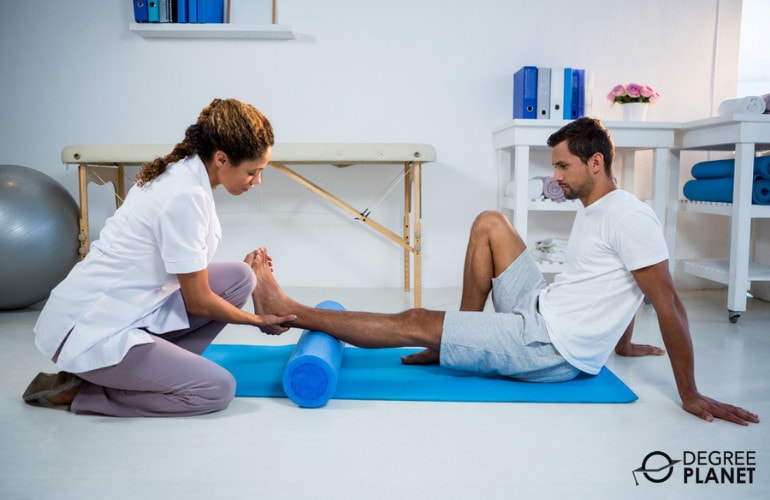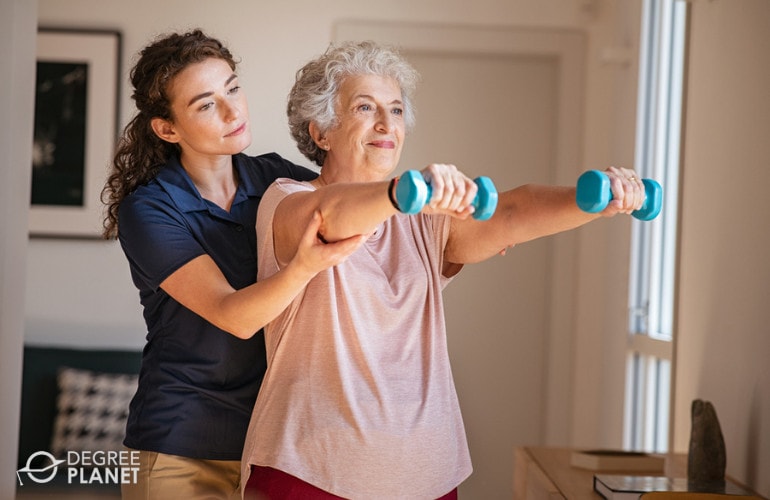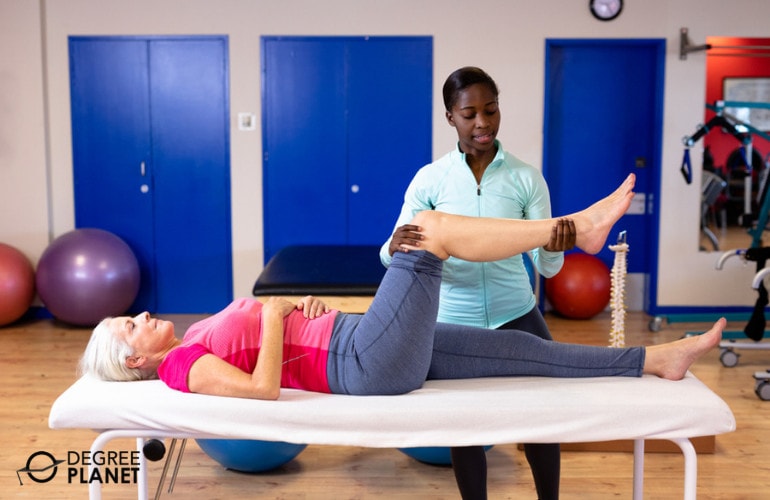If you’re looking for a medical career that doesn’t require tons of schooling and involves hands-on patient care, then you might want to look into physical therapy assistant programs online.

These programs can help you build a solid foundation with pre-med courses, such as anatomy and physiology.
Editorial Listing ShortCode:
They can also help prepare you to enter the field in a relatively short time.
Physical Therapy Assistant Programs Online

Online PTA programs can equip you with the skills and expertise needed to work with physical therapy patients. Patient care assistant often work in private clinics, hospitals, and rehabilitation facilities.
Many accredited schools offer PTA degree programs online. PTA programs usually involve earning an associate degree and include required courses in subjects like:
- Anatomy
- Physiology
- Kinesiology
In-person learning is typically required for labs and supervised practicums so you can get the hands-on training you need. There are a number of hybrid programs that combine in-person, hands-on learning opportunities with online coursework. It can be possible to earn a qualifying associate degree and obtain licensure in as little as 2 years.
Editorial Listing ShortCode:
In almost all states, becoming a practicing physical therapy assistant (PTA) also requires licensing. It can be beneficial to find out what’s specifically required by your own state licensing board. In addition to licensure, some PTAs also pursue certifications in specialized areas of physical therapy care in order to enhance their skills and job prospects.
Physical Therapy Assistant Careers & Salaries

This kind of vocationally oriented degree program can offer a well-defined pathway to becoming a licensed physical therapy assistant. Training includes relevant coursework in topics such as anatomy, physiology, kinesiology, and medical ethics, along with hands-on learning components and supervised clinical practicums.
According to the Bureau of Labor Statistics, physical therapy assistants and aides can earn a range of salaries, depending on their industry of choice.
| Careers | Annual Median Salaries |
| Physical Therapist Assistants — Nursing Care Facilities | $67,120 |
| Physical Therapist Assistants — Home Healthcare Services | $64,700 |
| Physical Therapist Assistants — Hospitals | $58,460 |
| Physical Therapist Assistants — Offices of Therapists and Audiologists | $58,050 |
| Physical Therapist Assistants — Offices of Physicians | $56,730 |
| Physical Therapist Aides — Nursing Care Facilities | $34,800 |
| Physical Therapist Aides — Hospitals | $30,620 |
| Physical Therapist Aides — Offices of Physicians | $29,760 |
| Physical Therapist Aides — Government | $28,360 |
| Physical Therapist Aides — Offices of Therapists and Audiologists | $27,080 |
Physical therapy assistants typically play an integral role in clinics or hospitals. They help licensed physical therapists with a range treatment and clinical support activities. A PT assistant’s tasks can include everything from providing regular hands-on patient care to helping with assessments, scheduling, and after-care follow up.
Physical Therapy Assistant Curriculum & Courses

You can often qualify for a career as a PTA with as little as an associate degree, and you’ll be taking some challenging life sciences courses and satisfying requirements for hands-on training. Here are some examples of courses you may take:
- Anatomy: You’ll learn about the structural organization and parts of the human body as well as the different anatomical systems, such as respiratory, muscular, skeletal, and nervous systems.
- Physiology: You’ll learn how different parts of the human body and different organs function and how they affect human health and performance.
- Kinesiology: This course explores the biomechanics of human movement as it relates to human anatomy, physiology, activity, and health.
- Sports Physiology: This course examines exercise and sports as they relate to human health and human physiology. It examines from the perspective of physical stress and injury or physical rehabilitation.
- Physical Rehabilitation: You’ll learn about different kinds of physical injuries, physical occupational stresses and hazards, and limiting physical impairments. You’ll also learn about principles and processes used for physical rehabilitation in clinical settings.
- Pathophysiology: This course focuses on the diagnosis and treatment of different kinds of physiological diseases or conditions that impair normal physical health, ability, and performance.
- CPR: This course covers the required certification in cardiopulmonary resuscitation procedures and related protocols for responding to patient health emergencies.
- Clinical Experience: Supervised residency practice allows you to get additional hands-on experience providing a range of common physical therapy treatments.
- Ethics in Clinical Settings: You’ll learn about important ethical standards and procedures related to patient care, patient records, and patient interactions.
- Written and Oral Communication: This course ensures that you have the essential workplace communication skills needed in clinical and medical settings.
If you’re up for this kind of science-focused curriculum, an accredited PTA associates degree program can help equip you with the knowledge you need to get licensed and jump into this rewarding field.
How to Choose an Online PTA Program

It can be helpful to consider the cost and flexible pacing of an online PTA program. Here are some additional factors to consider when searching for the program that’s right for you:
- Accreditation. Accreditation can be a precondition for financial aid as well as licensing or continuing your education down the road. Physical therapy programs can earn accreditation from the Commission on Accreditation in Physical Therapy Education (CAPTE).
- NPTE pass rates. Many schools provide information on their website showing their students’ passing rates on the National Physical Therapy Exam (NPTE). You may want to look for schools with high pass rates.
- Labs and clinicals. Some online programs offer lots of flexible scheduling and pacing, but you’ll still be required to do lab time and supervised clinical practice on location. You may want to pick a school that fits with your schedule and offers opportunities near where you live.
With this kind of checklist in mind, you may be able to better compare schools and determine what kind of school and program works well for your needs and interests.
Admissions Requirements

Admissions requirements often vary by school and program, but here are some common admissions requirements for physical therapy assistant associate degree programs:
- SAT or ACT scores (only some schools require them)
- High school diploma or equivalent
- Satisfactory GPA
- English proficiency
Many programs don’t have overly stringent admissions requirements. Once you’re enrolled, you’ll likely take some general education courses as well as required courses for licensing, such as anatomy, physiology, and kinesiology, among others.
Accreditation

When it comes to careers that involve clinical services and treatments, licensing boards and prospective employers often require you to complete your relevant coursework at a fully accredited school. Regional accreditation is the gold standard for schools.
Editorial Listing ShortCode:
Physical therapy assistant (PTA) programs can be accredited by the Commission on Accreditation in Physical Therapy Education (CAPTE). Organizations such as the Council for Higher Education Accreditation (CHEA) can help you learn more about accreditation and finding accredited schools.
PTA Licensure and Certifications

Most states require practicing physical therapy assistants (PTAs) to be licensed. Licensing requirements can vary from one state board to another, so it’s beneficial to check out your state’s specific requirements if you wish to pursue licensure. Getting licensed requires passing the National Physical Therapy Examination (NPTE). Some licensing boards also require that students hold a degree from an accredited school and program.
Practicing PTAs can also pursue supplementary physical therapy assistant certification. A certification can allow them to enhance their professional credentials for specialized areas of PTA practice in aquatic, cardiovascular, pediatric, or neuromuscular physical therapy.
Financial Aid and Scholarships

Financial aid can help cover some of the school costs for qualifying students in PTA programs. Financial aid can take many forms, such as federal and state aid, employer-based programs, need-based and merit-based scholarships, and student loans.
It’s helpful to review offers carefully, as terms and conditions can vary. If you plan to seek any need-based assistance, filling out the Free Application for Federal Student Aid (FAFSA) can be a good first step.
How Long Is the Physical Therapy Assistant Program?

Most online physical therapy assistant programs take about 2 years to complete. This timeline can include requirements related to coursework, in-person labs, and supervised clinical practice.
Given these requirements, it can sometimes take more than 2 years, based on individual circumstances and the program you select. There are also some programs that are designed to help you finish in as little as 18 months.
How Much Do Physical Therapy Assistants Make?

How much a physical therapy assistant can make varies based on many factors, including qualifications, certifications, experience, and work location.
According to the Bureau of Labor Statistics, physical therapy assistants earn a median salary of $59,770, and physical therapy aides earn a median of $28,450. Nursing care facilities tend to pay PT assistants the most, with a median salary of $67,120.
The majority of physical therapy assistants work in offices of audiologists and physical, occupational, and speech therapists. The median salary for PT assistants in this sector is $58,050 (Bureau of Labor Statistics).
What’s the Difference Between an Occupational Therapy vs. Physical Therapy Assistant Program?
Physical therapists focus on helping patients improve or recover physical movement and range of motion. Meanwhile, occupational therapists help patients maintain, improve, or recover abilities related to all kinds of day-to-day activities.
| Physical Therapy Assistant | Occupational Therapy Assistant |
|
|
Physical therapist assistants are likely to have more expertise in anatomy, physiology, and biomechanics. Occupational therapist assistants will likely be trained to assess and address physical, cognitive, and psychological factors related to a patient’s challenges.
What’s the Difference Between a Physical Therapist Aide vs. Assistant?
Physical therapy assistants are trained to assist doctors with physical therapy treatments and assessments, while a physical therapy aide provides non-therapeutic office support.
| Physical Therapy Assistant | Physical Therapy Aide |
|
|
Both a PT assistant and PT aide can work side-by-side in similar clinical settings, but a physical therapy assistant role requires more medical training. A PT assistant can also provide direct therapeutic services.
Is a Program in Physical Therapy Assistant Worth It?
Yes, a program in physical therapy assistant is worth it for many students. With PTA training and licensure, you could help fill the need for qualified physical therapy assistants.
In fact, the Bureau of Labor Statistics projects 33% job growth for physical therapy assistants over the next ten years, which is much faster than average. You could potentially complete your PTA training program in 2 to 3 years and be on your way to assisting patients and physical therapists.
Editorial Listing ShortCode:
Your learned PTA skills could also help you down the road if you ever desire to pursue additional qualifications in physical therapy or even look into how to become a physical therapist or a related profession. This would require earning a doctorate, which you could accomplish by entering one of the Doctor of Physical Therapy programs that a number of universities offer.
Universities Offering Online Certificates or Diploma in Physical Therapy Assistant Programs
Methodology: The following school list is in alphabetical order. To be included, a college or university must be regionally accredited and offer degree programs online or in a hybrid format.

The Borough of Manhattan Community College offers a Physical Therapy Aide Certification. The program seeks to teach students the skills required to successfully support future clients in a variety of settings. This fully online program admits new students on a rolling basis. The curriculum covers essential topics like ethics, physiology, sanitation, communication, and practice administration.
BMCC is accredited by the Middle States Commission on Higher Education.

The College of Staten Island offers a program to become a Certified Physical Therapy Aide. The program is 100% online. Upon successful completion, students are eligible to take the American Medical Certification Association’s Physical Therapy Technician/Aide certification exam. The curriculum covers medical terminology, organization of the human body, infection control, and other related topics.
CSI is accredited by the Middle States Commission on Higher Education.

Pennsylvania Highlands Community College offers a Certified Physical Therapy Aide program. It is designed to prepare students for the AMCA’s Physical Therapy Technician/Aide certification exam. The program includes an externship starter kit. Topics covered in this program include the basics of human anatomy and ethical and legal behavior in healthcare settings.
Pennsylvania Highlands Community College is accredited by the Commission on Higher Education of the Middle States Association of Colleges and Schools.

Prince George’s Community College offers a Physical Therapy Aide program. It is designed to help students obtain entry-level access to the growing career field of physical therapy. Students are expected to learn about clinical essentials in a convenient online format and then complete a 52 hour, on-site clinical experience.
PGCC is accredited by the Middle States Commission on Higher Education.

SUNY Corning Community College offers a 100% online program to become a Certified Physical Therapy Aide. Its purpose is to help students develop the knowledge and skills needed to provide physical therapy patients with positive experiences. This program comes with an externship starter kit and is designed to prepare students for taking the AMCA’s certification exam.
SUNY Corning Community College is accredited by Middle States Commission on Higher Education.
Getting Your Physical Therapy Assistant Certification Online

If you’re interested in a medical career that allows you to work with patients but doesn’t require extensive schooling, then you might want to look into physical therapy assistant programs.
There are many fully accredited PTA programs that are now offered as online or hybrid programs. Hybrid programs typically allow you to complete your coursework online and your hands-on training in person.
The sooner you start exploring PTA programs, the sooner you can start your physical therapy assistant training!

